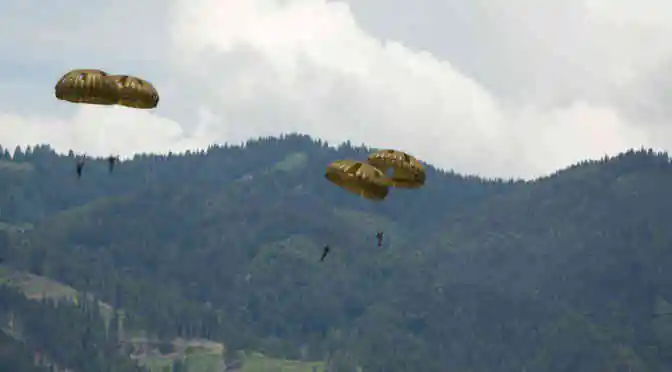What do skydivers and the Marines have in common? Commercial or military parachutes, of course. The impeccably constructed line that separates an adrenaline rush or successful air deployment from almost certain doom, the global parachute industry serves a very niche audience comprising of defense agencies, skydiving/adventure sports establishments and defense Original Equipment Manufacturers (OEMs). The market might be selective, but is still expected to peak at USD 1,112.03 million by the year 2021, as pointed out by Technavio in their influential industry research report.
Market Drivers : Of Armed conflicts & adrenaline rushes
In a world engulfed in strife, the principal drivers that will positively impact growth in the global commercial and military parachute market will naturally be connected to the militaries of the world. Growing instances of joint para-trooping exercises, increased usage of parachute bombs and, a growing demographic of thrill seekers who utilize parachutes in recreational activities, have positively contributed to the growth of this industry. A commendable CAGR is expected for 2017-2021.
Challenges Galore : Rules & reliability
True to a commodity that should never fail operationally, the spells and checks imposed on the commercial and military parachute industry are very stringent. In most instances, the decision makers are on the ready to identify potential breaches of these regulations and will punish such indiscretions harshly. Lawmakers are constantly tweaking the rules to ensure public safety and responsible behavior where dangerous activities such as skydiving is concerned, and this impacts the parachute industry negatively. Importantly, numerous reports of the failure of the T-11 (non-maneuverable military parachute) and the unfortunate deaths of skydivers due to parachute malfunction ensure that there is always a haze of doubt with regards to the parachute’s practicality and safety. This most definitely impacts the product’s mass adoption rates and consequently, the vendors’ bottom line.
Greener pastures : And how to land there?
Just as any other specialty, growth in the commercial parachute industry is dependent on continuous innovation and the unlocking of potentially new customer preferences and demographics. Currently, development is centered on the inclusion of nanotechnology in the manufacture of parachutes, a radical new idea that will reduce the hauling weight of the latter and make it more practical and efficient. Still in the early stages of development, we could potentially witness nanotechnology imbibed parachutes by the year 2021. Further, with the US Army’s insistence on the ‘dominating maneuver’- a series of precision steps that will help the army control a volatile situation by a) arriving quickly on the scene, b) destroying the enemy’s center of gravity with calculated strikes and deployments- the need for heavy-duty parachutes that will flawlessly aid in precise air drops has incremented exponentially. And finally, parachutes are increasingly finding favor in fitness training sessions where they are strapped on an athlete’s back and offers him/her an additional quantum of resistance to overcome as he/she is sprinting or indulging in the usual fitness activities. This trend is predicted to gain more popularity through the 2017- 2021 timeframe.
The Technavio Advantage : Helping You Make Sense of it All…
Thus far, we have analyzed the overview, challenges and scope of innovation in the global parachute industry. These insights and other highly accredited data, in its entirety and with case specific annotations, can be sourced from the expertly compiled market research report from Technavio. This generalized document touches upon all the finer aspects of the global parachute industry, including current and evolving trends, challenges, industry drivers, prominent players and their market strategies. Contained in 70 pages, this comprehensive document can be sourced thus,




